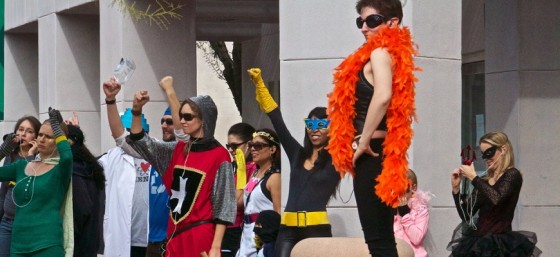
(Creative Commons License)
Public events present fantastic opportunities for photographers to take captivating photos, but before you pull out your camera, you need to understand some of the legal do’s and don’ts of shooting in public.
What is “Public?”
What is public versus private is a challenging question for some people to comprehend. There is a difference between being “in public” and being on “public property.” Many places where the public is invited to be, such as shopping malls, convention centers, fairgrounds, and stadiums are in public because you’re in a place where many members of the general public can see you, but you’re still on private property, and can be asked to leave if you’re breaking the rules.
Even when events are on public property, like street fairs and events at public parks, these areas are like private property for the purpose of the event. The organizers likely obtained an event permit from the city, part of which gave them permission to enforce stricter rules regarding photography than what you would have to follow if you were merely walking down a public street.
Their Event. Their Rules.
When you want to shoot at an event, try to find the photography rules. When you enter the event, look for notices. Many times, the organizers post a notice that says by entering the premises, you agree that the event organizers can take your picture and use the images for any purpose. These notices do not apply to you unless you are a photographer hired for this purpose.
Here’s where you can look for information about whether you can legally take photos at an event.
- If the event is on private property, look for a list of rules on the wall. Many shopping malls and stores have rules that prohibit shooting photos or video on the premises.
- If you are attending a sporting event or concert, check the back of your ticket. If there is fine print, that is likely a contract between you and the event or venue, which may include terms about taking photos.
- Check the website for the event or venue to see if they are specific rules regarding photography at the event. Many times, this is in the frequently asked questions (FAQ) section. If the event is out in the open, like at a park or fairground, I would not expect there to be rules that prohibit photography, but I have seen “No Photography” signs on vendor booths at art festivals where artists were selling original works.
Rules of Thumb for Shooting Photography in Public
Here are some general rules when taking photos at public events.
1. Don’t be creepy. Don’t stare at people, follow them around, or act like a stalker. I’ve heard about this type of behavior at cosplay events, including a few years ago at Phoenix Comicon where someone shot video of women without their consent, and posted a compilation where the purpose was to objectify them. (The video has since been removed.) Now, it’s more common to see rules at these events that include a zero tolerance policy for this type of behavior.
2. Ask permission if you can take someone’s photo. This is particularly true if you’re taking photos of someone else’s child.
3. Be ready for questions from security, ushers, and/or event attendees. If you are using a high-end camera when most people are using their smart phones, you may raise suspicions. This is especially true if you or the person you’re shooting are doing anything abnormal.
As a former gymnast, I like to do handstands. When my friends and I went to an Arizona Diamondbacks baseball game, I decided to do in the stands. We did it right before we left: I kicked a handstand, my friend took the picture, and we immediately walked up the stairs to leave. As expected, an usher stopped us as we reached the top. I was ready for him to say we needed to leave, but thankfully he was curious to know what we were doing.

4. Remember, if you don’t have a model release, you likely can’t use the images that contain identifiable persons for commercial purposes, including marketing yourself, without the risk of being accused of violating the person’s right of publicity. (Check your state’s law to see what the rules about publicity rights are before you take photos of others, especially strangers.)
5. When you are taking photos on public property – not at a private event, know the applicable laws. You may encounter people who make false statements about the law, and you have to correct them.
For example, Improv AZ has organized the No Pants Light Rail in Phoenix every year since 2009. It takes place on the public light rail system with the general public, and we have official photographers who ride with us, sans pants, to document it. One year, we encountered light rail security who tried to tell one of our photographers that he couldn’t bring his camera on board, because it would be a violation of the law. We stood in the door of the light rail car – one foot in the car, one foot on the platform – which forced the door to stay open, so our photographer wouldn’t get left behind. We explained the law to the security guard and asked him to call his supervisor, who confirmed that everything we were saying was true, and we continued with the Ride.
The best way I can encompass the rules for shooting photographs at public events is Be Aware, Be Thoughtful, and Make Good Decisions.
Lights Camera Lawsuit
There’s always a need for quality legal information for photographers. That’s why I created an online course called Lights Camera Lawsuit: The Legal Side of Professional Photography to address photographers’ most important questions. I want you to feel secure in your business, confident in the way you operate day-to-day, knowing that you’ve set yourself up to get paid what your worth without incident.
At $497, the course contains nearly six hours of legal information you can immediately apply to your business. That’s less than what I charge for two hours of legal work for clients!
Please subscribe for more information and to make sure you don’t miss out on any special offers or discounts.




